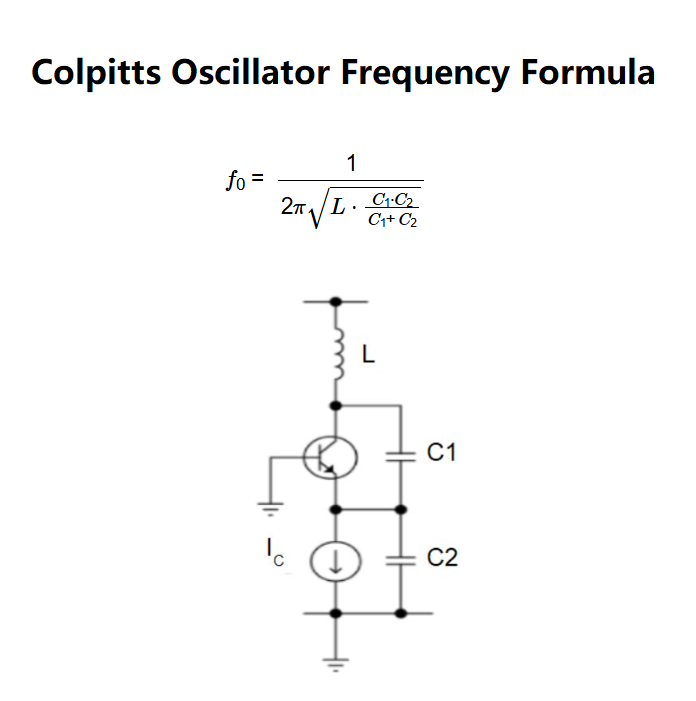 Home
Home
 Back
Back

Definition: This calculator computes the resonant frequency (\( f_0 \)) of a Colpitts oscillator based on the inductance (\( L \)) and the capacitances (\( C_1 \), \( C_2 \)) of the two capacitors in the circuit.
Purpose: It is used in electrical engineering to determine the oscillation frequency of a Colpitts oscillator, a type of LC oscillator commonly used in RF circuits, signal generators, and communication systems.
Resonant frequency is calculated using:
Inductance conversions:
Explanation: The input inductance (\( L \)) is converted to henries, and the capacitances (\( C_1 \), \( C_2 \)) are converted to farads. The equivalent capacitance is calculated as \( \frac{C_1 \cdot C_2}{C_1 + C_2} \), and the resonant frequency is computed in hertz (Hz). The frequency is then converted to kilohertz (kHz), megahertz (MHz), and gigahertz (GHz) for display. Small frequency values are shown in scientific notation for clarity.
Details: The resonant frequency of a Colpitts oscillator determines the frequency at which the circuit oscillates, which is critical for applications like RF signal generation, frequency synthesis, and communication systems. Accurate calculation ensures the oscillator operates at the desired frequency.
Tips: Enter the inductance (\( L \)) in H, mH, or µH, and the capacitances (\( C_1 \), \( C_2 \)) in F, µF, nF, or pF (all values must be greater than 0). The result will be the resonant frequency in hertz (Hz), kilohertz (kHz), megahertz (MHz), and gigahertz (GHz). Frequencies less than 0.00001 Hz will be displayed in scientific notation.
Examples:
Q: What is a Colpitts oscillator?
A: A Colpitts oscillator is a type of LC oscillator that uses an inductor (\( L \)) and two capacitors (\( C_1 \), \( C_2 \)) to generate a sinusoidal signal at a specific frequency. It’s widely used in RF applications due to its stability and simplicity.
Q: Why must inductance and capacitances be greater than zero?
A: The formula involves the square root of \( L \cdot \frac{C_1 \cdot C_2}{C_1 + C_2} \), which requires all values to be positive. If any value is zero, the denominator becomes infinite or the expression under the square root becomes zero, leading to an undefined or zero frequency.
Q: What are typical values for inductance and capacitance in a Colpitts oscillator?
A: Typical values depend on the desired frequency. For RF applications, inductance might be in the range of 1 µH to 1 mH, and capacitances might be 1 pF to 1 nF. For lower frequencies, larger values like 1 mH to 1 H and 1 µF to 100 µF might be used.
Q: Why are small frequency values displayed in scientific notation?
A: Frequencies less than 0.00001 (e.g., \( 1 \times 10^{-5} \)) are displayed in scientific notation for clarity, as they are very small and would otherwise show as long strings of zeros in decimal format (e.g., 0.000000712319 Hz becomes \( 7.123192e-07 \, \text{Hz} \)).
Q: Why is the frequency displayed in multiple units (Hz, kHz, MHz, GHz)?
A: Colpitts oscillators can operate over a wide range of frequencies, from a few hertz to gigahertz, depending on the application. Displaying the frequency in hertz, kilohertz, megahertz, and gigahertz provides flexibility for different use cases, such as audio frequencies (Hz/kHz) or RF frequencies (MHz/GHz).